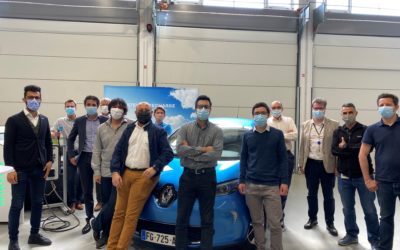5G for connected and automated cooperative mobility: towards greater safety and efficiency 21 April 2022, 9 AM - 6 PM Organisation : VEDECOM, Catapult, AKKA Technologies and VALEO Location: VEDECOM headquarters at mobiLab and Satory tracks, Versailles. 23 bis allée...
The Mobena initiative accelerates the roll-out of new generation e-Mobility
Mobena harmonizes the deployment of new services for EV charging
May 17, 2021. The Mobena initiative was created in July 2020 by the main French professional organizations representing the electromobility ecosystem in the French market. The goal is to simplify the user experience by ensuring interoperability between charging systems and leading the way towards the deployment of a new generation of EV charging in the French market. The initiative now reaches two key milestones:
- the demonstration of an interoperability solution between multiple PKI (Public Key Infrastructure), organized with international partners of June 2nd, 2021. Learn more
- the kick-off of a collaborative project that gathers the e-Mobility actors and aims for ensuring a successful roll-out of the new EV charging services in the French market.
Towards an open and fair market with a reference architecture
The Mobena initiative’s objective is to ensure a successful deployment in the French market of the ISO 15118 services (Plug and Charge -PnC- and smart charging) in a harmonized way with Europe.
To do this, adopting a reference architecture, from technical and organizational point of view, is key. Such architecture shall ensure interoperability and enable an open and fair market between all EV actors and allow end-users and operators to freely select their providers.
A first technical feasibility verification

In preparation for the event planned on June 2nd, the Mobena initiative partners tested the technical feasibility of the Certificate Trust List (CTL) as a solution for Plug and Charge (PnC) interoperability between multiple PKI.
On March 11th 2021, VEDECOM hosted a Workshop for this objective at mobiLAB with the contribution of Freshmile, GIREVE, Hager, Groupe Renault, Stellantis, SAP Labs, Thales et Trialog
About the Mobena initiative
The Mobena initiative was created in July 2020 by the main French professional organizations representing the electromobility ecosystem in the French market. The goal is to simplify the user experience by ensuring interoperability between charging systems and leading the way towards the deployment of a new generation of EV charging in the French market.
Coordinated by VEDECOM, the Mobena initiative committee regroups AFIREV, AVERE-France, PFA, GIMELEC, UFE and VEDECOM.
![]()
About twenty companies representing the different roles in the ecosystem have joined this initiative. The mission is to support the players of the EV charging ecosystem, operating in France, by defining the roadmap and the means to ensure a successful and harmonized deployment of the e-Mobility services. The Mobena project, which will be launched in July 2021 and extended to more partners, will particularly focus on integrating interoperability as an initial requirement and providing high added value services through a massive adoption of the ISO 15118 standard in a competitive and open market.
A particular focus will be put on Smart Charging, Plug and Charge and the implicated end-to-end system interfaces, including backend communication protocols (OCPP, OCPI…), PKI and cyber security. This for both AC and DC charging.
For more information: Joe.matta@vedecom.fr
More information about Mobena initiative:
-
July 8, 2021: France prepares to introduce New-Generation Electric Mobility
- Oct 18, 2020: French industry has engaged in a collective Initiative for New-Generation Electric Charging
MOBENA website







